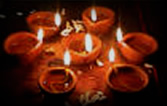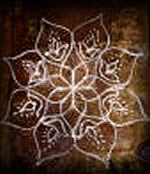 |
 |
Diwali
diyas |
Lotus
rangoli |
Diwali, the Hindu festival of lights, is the most popular of all the festivals from South Asia, and is also the occasion for celebrations by Jains and Sikhs. Extending over five days, it celebrates the victory of good over evil and knowledge over ignorance, although the legends that are used as symbolic manifestations of this victory vary in different regions.
The name of the festival comes from the Sanskrit word dipavali, meaning “row of lights”. Small earthenware lamps called diyas, traditionally fueled by mustard oil, are placed in windows, doors and outside buildings—although nowadays these are often replaced by strings of electric lights, particularly in larger towns.
For many Indians the festival honours Lakshmi, the goddess of wealth. The new business year starts at Diwali, and some Hindus will say prayers to Lakshmi for a successful year. Windows and doors are left open to make it easy for her to enter, and special patterns, rangoli, are drawn on the floor, the most popular being the lotus flower. There is much feasting and celebration, and the lamps are meant to make it easy for Lakshmi to find her way into the house.
Another legend that speaks of the origin of this festival regards the killing of the demon Ravana, who had kidnapped Sita, the wife of Rama. Rama had been in exile for 14 years because of a disagreement regarding whether he or his brother should be the next king. He journeyed to Ravana’s kingdom to recover Sita, and after a great battle the demon was defeated. It was a dark moonless night when Rama and Sita returned home, and people put little lamps outside their houses so that the two could find their way. Thus began the tradition of the festival of lights, during which, in many places, Rama’s coronation as king is also celebrated.
In 1577 CE, in recognition of the day’s importance, Diwali was chosen for the laying of the foundation stone of the Golden Temple at Amritsar. The Sikh community also associate Diwali with the freeing from imprisonment of the sixth guru, Guru Hargobind, in 1619 CE. According to tradition, the Guru agreed to be freed only if the rajahs imprisoned with him were also released. The Moghul emperor Jahangir was under pressure from moderate but influential Muslim religious leaders. Eventually he relented, with one proviso: “Let only those rajahs be freed who can hold on to the Guru’s coat tails and walk out of prison.”
In response, Hargobind asked for a special coat to be made with 52 coat tails, the number of imprisoned rajahs. After they had all been released, the Guru became known popularly as the Bandi Chhor, “deliverer from prison”. He arrived at Amritsar on Diwali and the Golden Temple was lit with hundreds of lamps, a reception akin to the one granted in legend to Rama and Sita. Eventually, for Sikhs, Diwali came to be known as Bandi Chhor Divas, the “day of freedom”.
The Jain community also celebrate Diwali, remembering it as the day on which Mahavira, the founder of Jainism, attained moksha, eternal bliss.